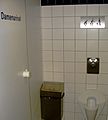Urinal facts for kids
A urinal is a special type of toilet fixture. It's mainly designed for peeing, especially for males in public places like schools, malls, or sports stadiums. You can find different kinds of urinals, some made for one person and others that are longer, like a trough, for several people to use at once.
-
A steel urinal that many people can use at once.
-
Urinals from Ancient Rome in a place called Ostia Antica.
Contents
What is a Urinal?
A urinal is a plumbing fixture that helps people pee quickly and efficiently. They are usually found in public restrooms, especially in places that get a lot of visitors. Urinals are often designed to save water compared to a traditional toilet.
How Urinals Work
Most urinals have a simple flushing system. After someone uses it, a small amount of water washes the bowl clean. Some modern urinals are even "waterless," meaning they don't use any water to flush. Instead, they have a special trap that blocks odors. This helps save a lot of water.
Types of Urinals
There are a few main types of urinals you might see:
- Wall-mounted urinals: These are the most common type. They are attached to the wall and are usually made for one person.
- Trough urinals: These are long, open fixtures that can be used by several people at the same time. They are often found in older public restrooms or places with very high traffic.
- Waterless urinals: As mentioned, these don't use water. They have special technology to keep them clean and odor-free.
- Female urinals: While less common, some urinals are designed specifically for women. These are often shaped differently to make them easier for women to use.
History of Urinals
People have been creating special places for public urination for a very long time.
- Ancient Times: Even in Ancient Rome, there were public facilities for people to relieve themselves. The image in the gallery shows an example from Ostia Antica.
- 19th Century: In the 1800s, public urinals became more common in cities, especially in Europe. They were sometimes called vespasiennes in France, named after a Roman emperor who taxed public toilets. These early urinals helped keep city streets cleaner.
- Modern Times: Over time, urinals became more private and hygienic. Today, they are a standard part of most public men's restrooms around the world.
More Pictures
-
A "Public Convenience" sign in Varanasi, India.
-
The last surviving vespasienne (an old type of public urinal) in Paris.
-
A vespasienne in Honfleur, France.
-
An old public urinal with three stalls in Paris around 1865.
See also
 In Spanish: Urinario para niños
In Spanish: Urinario para niños












